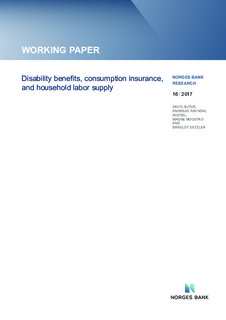| dc.description.abstract | While a mature literature finds that Disability Insurance (DI) receipt discourages work, the welfare implications of these findings depend on two rarely studied economic quantities: the full cost of DI allowances to taxpayers, summing over DI transfer payments, benefit substitution to or from other transfer programs, and induced changes in tax receipts; and the value that individuals and families place on receiving benefits in the event of disability. We comprehensively assess these missing margins in the context of Norway's DI system, drawing on two strengths of the Norwegian environment. First, Norwegian register data allow us to characterize the household impacts and fiscal costs of disability receipt by linking employment, taxation, benefits receipt, and assets at the person and household level. Second, random assignment of DI applicants to Norwegian judges who differ systematically in their leniency allows us to recover the causal effects of DI allowance on individuals at the margin of program entry. Accounting for the total effect of DI allowances on both household labor supply and net payments across all public transfer programs substantially alters our picture of the consumption benefits and fiscal costs of disability receipt. While DI denial causes a significant drop in household income and consumption on average, it has little impact on income or consumption of married applicants; spousal earnings and benefit substitution entirely offset the loss in DI benefit payments. To develop the welfare implications of these findings, we estimate a dynamic model of household behavior that translates employment, reapplication and savings decisions into revealed preferences for leisure and consumption. We find that household valuation of receipt of DI benefits is considerably greater for single and unmarried individuals than for married couples because spousal labor supply substantially buffers household income and consumption in the event of DI denial. | nb_NO |

